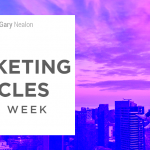What was on the minds of industry professionals and technology experts this week? Apparently a great deal!
From social media marketing tools to drive your strategies forward, to Google’s unofficial auto search update, a handy content marketing glossary, the top blogging trends right now, a look into the metaverse, and much more.
Let’s take a look at the top marketing and ecommerce articles in this week’s round-up.
1. “The Essential Content Marketing Glossary: 50+ Terms You Need To Know” by Jodi Harris
At first glance, content marketing may not seem overly complicated; create content, push it out, and watch your reach and follower count climb. However, that’s just the very tip of the iceberg. What falls under the umbrella of content marketing is incredibly vast, which at times can be slightly confusing. Here to help this week with an incredible content marketing glossary is social media professional Jodi Harris.
This superb guide names just about everything to do with content marketing, and includes a whopping 50 terms and definitions to make sure you’re across it all. Harris broke her glossary down into different sections and areas of content marketing to make things easier including strategy-centric terms, planning and processing terms, creation terms, and sale-centric terms.
Content marketing is changing all the time as technology progresses and social platforms evolve. To make sure you’re up to speed, this glossary is well worth checking out.
2. “The 23 Best Social Listening Tools to Monitor and Empower Your Marketing” by Neal Schaffer
Most of us should know by now that analyzing and monitoring your social media is important. However, it’s also a task that can be time-consuming as well. Thankfully there is now an abundance of social media listening tools to help, which Neal Schaffer covered on his blog this week.
Some of the tools Schaffer suggests in the article include Buffer if you’re wanting to hone down on information directly related to your audience and reach, Hootsuite if you want a one-stop tool for all your social media management and analysis, Meltwater if you’re after a tool to monitor social media and beyond including blogs and website mentions, and SEMRush for a tool that monitors social media as well as SEO.

(Source)
If you’re looking to use a social media listening tool, or perhaps want to upgrade, Schaffer’s article lists some great options which will be sure to help you choose the best platform for your needs.
3. “How to Increase Your Share of Voice on Social Media” by Roza Tsvetkova
Once you’ve chosen a social listening tool and started analyzing your results, a common and useful metric that you may come across is share of voice (SOV). You may be asking: why is SOV so important and what can I do with such a metric? Roza Tsvetkova has all the answers you need in her article this week.
According to Tsvetkova, SOV is the best metric to tell you where your brand stands when competing for market share on social media. In particular, the SOV metric can help you to better understand your audience, who and what they are listening to, aid you when researching your competition, and then how you can benchmark against them.
In the article, Tsvetkova also outlines several ways, and a few tools, to help you correctly measure your SOV, as well as some suggestions on how to use these statistics to drive results.
This rundown is a great read to get you quickly using the SOV metric to enhance your social strategy, and may even help you discover emerging trends and gaps in the market to inspire new products.
4. “The 6 Biggest, Baddest Social Media Platforms of 2022 (+How to Wield Their Power)” by Kristen McCormick
Continuing with the topic of social media was expert Kristen McCormick, with an in-depth guide on the current social media landscape.

(Source)
In the article, McCormick runs through all the current statistics on the top social media sites including Facebook, Instagram, Twitter, Pinterest, LinkedIn, and TikTok. She then looks at each platform independently, outlining explicitly how they are used, who the audience is, what benefits they can bring to a business, and how you can and should approach them.
For example, Instagram has become incredibly useful for those in ecommerce, whereas LinkedIn is where you should head for your B2B marketing. This guide is a fantastic look into the current social media landscape and is full of key information to help guide your social media strategies.
5. “The Metaverse: What To Think, How And When To Care” by Zain Jaffer
I’m sure you’ve heard the term metaverse<span< a=””> data-preserver-spaces=”true”> being thrown around a lot recently. Sure, it’s a buzzword, but the changes that are taking place with the internet these days are something that can’t be denied.</span<>
You’ve most likely heard it spoken by folks like Meta’s (Facebook’s) Mark Zuckerberg or Microsoft’s Satya Nadella when they’ve spoken about the future of the internet. If you’re still confused, investor and entrepreneur Zain Jaffer gave a fascinating viewpoint on the subject this week which is sure to help you better understand.
According to Jaffer, the metaverse is a transition that’s currently taking place, shifting the way we interact with technology. Early adaptations of the metaverse were mostly to do with gaming, such as virtual reality. However, today, the metaverse is much greater and includes multiple technical components, like the growing online economy of NFTs, the way we absorb information, and various entertainment platforms.

(Source)
Although the term is just now entering the mainstream, you can expect to hear it a whole lot more over the next few years as more and more companies get involved. For a far more in-depth rundown on the subject, and what it might mean for your ecommerce business, Jaffer’s article is worth a read.
6. “The 12 Best Competitive Intelligence Tools for Market Research” by Elena Kozlova
Regularly conducting market competition research is essential to staying ahead of competitors, anticipating industry trends, and having an overall better understanding of your own market. And, of course, just like there is a bounty of tools to help with social media listening, there are plenty of excellent tools to help you conduct market research too.
Elena Kozlova from Semrush Blog covered the subject this week, listing a bunch of these tools to help you out with the job. To save you time, Kozlova broke down her list of tools into need-based categories, such as tools to help with a general sense of your market, such as G2 Crowd, tools to analyze competitor strategies, such as Wappalyzer, and tools specifically for ecommerce websites, such as Visual Ping.
Market intelligence tools have drastically come down in price over the last few years, making right now a great time to rethink how you’re currently conducting your market research. Take a look at Kozlova’s article to find the tools best suited to your business needs.
7. “6 Blogging Trends to Capitalize on This Year” by Neil Patel
Do you use blogging as part of your marketing strategy but worry that it’s a dying trend? Neil Patel tells you otherwise in his article this week that covered the subject and will reassure you that it’s a format here to stay.
According to Patel, blogging is a strategy currently used by more than 600 million people and companies worldwide. However, the trick to successful blogging today is to spot the new trends when they arise, to ensure you are producing the right kinds of content, and keeping your audience engaged. To help with that, Patel suggested six different blogging trends and how to capitalize on them this year.
Some of these trends include ensuring your blog has a mobile format, implementing affiliate marketing into your content, using visual content, and paying attention to estimated reading time. If your blog could do with a bit of a shakeup, this article is a great one to check out.
MORE on getting started with blogging at the end of this article!
Get our Top 10 Must-Read Ecommerce Marketing Tips of the Week – Content Marketing Glossaries, the Metaverse, Google Updates, and More! - Worksheet delivered right to your inbox.
8. “How Google’s Roadmap for MUM Will Impact SEO in 2022 and Beyond” by Ben Jayston
One of the biggest SEO changes to occur last year was Google’s launch of its Multitask Unified Model (MUM) technology, which many experts have advised to pay particular attention to this year. Making sure you have your bases covered was SEO consultant Ben Jayston who, this week, gave an excellent rundown on the topic on Business 2 Community.
According to Jayston, the key facts to note about the MUM update are; that the technology is 1,000 times more powerful than BERT, it can understand and create content across more than 75 languages, it can understand information and items in text, images and video, and is capable of analyzing and answering complex queries like never before.

(Source)
That may seem like a lot to process, and the truth is, it is. This update is huge, and it is changing a great deal to SEO. Lucky for you, Jayston’s article is a great guide that covers everything you need to know about the MUM update and how to tackle it this year.
9. “What Google’s Enhanced Autocomplete Box Means For SEO” by Kristopher Jones
Although not officially announced, another update Google has begun to roll out is its enhanced autocomplete search box, which many experts have been speculating over for the past few months. SEO expert Kristopher Jones is one of them and reviewed the current state of the un-announced update this week.
According to Jones, Google is currently beta testing this new autocomplete search box which, from what has been seen so far, is incredibly powerful. Put simply, the beta search box works to blend search results with other elements on the results page.
In the article, Jones uses the search for ‘Pizza’ to explain how the beta is currently functioning. For example, when Jones simply searched for pizza, Google bought up nearby pizza restaurants instead of a definition to describe pizza. The significance of this is that Google is assuming that Jones searched for pizza because he wants to eat it, instead of finding out information on the food.
As mentioned above, this update is still in beta. However, it’s got plenty in the industry excited and giving guesses as to how it will change SERPs in the long run. If you’re wanting to get up to speed on this update, I recommend giving the article a further read.
10. “Developing Brand Image: Chatbots Are B2B Marketers’ Secret Weapon” by Jacob Lucas
How many times do you visit a website today and a chatbot pops up? Or you go to find a business’s Facebook page and an automatic message appears. That is because the use of chatbots is a new trend that marketers have started to use to engage with their audiences, which digital marketing consultant Jacob Lucas covered more about on Marketing Profs this week.
According to Lucas, social media has, for many years, started to break down the professional barrier between a company and their audience. The professional tone of voice that companies previously used to communicate with their audience is being thrown out the window for a more casual and natural style. This is where chatbots come in.

(Source)
Whether it’s by implementing a chatbot to answer FAQs, or to start general conversations with customers on your website, this technique is a great way to form a more meaningful and real relationship with your customers that will modernize your brand image. If implementing a chatbot is something you think your business could benefit from, give this article a further read.
The Next Step
So if you haven’t done so already, the next step would be to make sure you have a strong web presence with your website and blog. If you’ve not been serious about blogging for a while, now is the time to come up with a content plan, and outsource the work to a good team who will be able to create content for you.
Step one: Create a content strategy. Come up with a content plan that will draw in your target audience.
Make sure you know who your target audience is, and try to pinpoint keywords that they’ll be searching to find your product and blog.
Step two: Create content. Once you’re clear on your audience, you’ll be able to work out from there, creating content that reaches them exactly where they’re at in the buyer’s journey.
Tip: Not sure where to start? Your FAQ page is a good place to get content inspiration. Or, check to see what search terms people are using to find your site. Or, see what other questions are coming up on your competitors’ Amazon pages or review sites. For example, let’s say that your company sells lamps. If you see that “What’s the best type of lamp for an office?” is a trending question, you can create a blog post answering that exact question.
Do you need some more advice to help drive your e-commerce and digital marketing plans? Get in touch with me today for your 20-minute free consultation.
Get our Top 10 Must-Read Ecommerce Marketing Tips of the Week – Content Marketing Glossaries, the Metaverse, Google Updates, and More! - Worksheet delivered right to your inbox.







